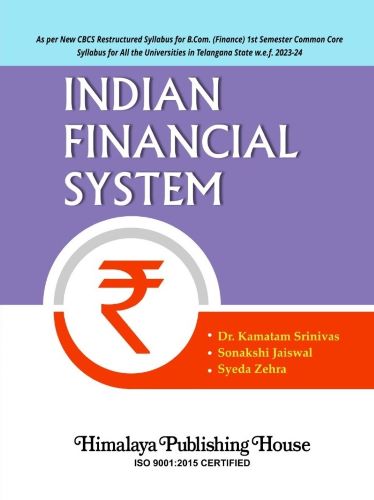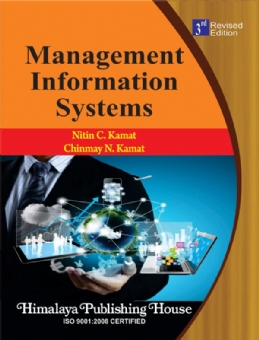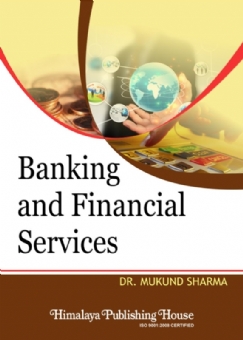Understanding the “Indian Financial System” is critical for commerce students as they are light-bearers of the finance sector. “Indian Financial System” emerges as a beacon, illuminating the path to comprehension in this dynamic field.
This textbook provides a thorough overview of the main components of India’s Financial System. This book provides an in-depth foundation targeted to the needs of undergraduate commerce students, as well as for other professional courses like CA, CMA, CS including topics from banking and financial markets, financial institutions and regulatory systems. This book is divided into five chapters covering the entire syllabus. The first chapter covers various aspects of finance, starting with an Introduction to the Financial System, including its meaning, functions, components, and its role in economic development. It also discusses recent developments and weaknesses in the Indian financial system. The subsequent second chapter deals with Financial Institutions, markets, products, roles, functions, and regulations. The third chapter discusses the different types of Financial Markets, starting with capital markets, which include primary and secondary markets, and money markets, covering various segments. In the fourth chapter, the focus shifts to Financial Products, including securities like stocks, bonds, and mutual funds, derivatives such as forwards, futures, options, and swaps, commodities, etc. The discussion primarily revolves around their meaning, types, and theoretical aspects. The last chapter specifically focuses on Financial Services, including fund-based services like leasing and hire purchase, as well as fee-based services such as issue management and credit rating services.
Crafted with clarity and quality, it not only simplifies important concepts but also inspires critical thinking and fosters an enhanced understanding of the relationship between economic theories and real-world financial practices. Through conceptualization and practical examples, students gain an understanding of the financial markets, the modern innovative products of the new era, the complexities of financial intermediation, risk management and the practical aspects of Futures and Options in the stock market.
Contents –
1. Introduction
1.1 Objectives
1.2 Introduction
1.3 Meaning and Definition of the Indian Financial System
1.4 Functions of the Financial System
1.5 Components of the Indian Financial System
1.5.1 Financial Institutions
1.5.2 Financial Markets
1.5.3 Financial Instruments
1.5.4 Financial Services
1.6 Flow of Funds Matrix
1.7 Role of Financial System in Economic Development
1.8 Recent Developments in the Indian Financial System
1.9 Weaknesses of Indian Financial System
1.10 Questions
1.10.1 Fill in the Blanks
1.10.2 Multiple Choice Questions
1.10.3 Write Short Note On
1.10.4 Essay Type Questions
2. Financial Institutions
2.1 Objectives
2.2 Introduction
2.3 Meaning and Definitions of Financial Institutions
2.4 Features of Financial Institutions
2.5 Role of Financial Institutions in the Financial System
2.5.1 Types of Financial Institutions
2.5.2 Banking Institutions
2.5.3 Non-banking Institutions (NBFC’s)
2.6 Functions of Financial Institutions
2.7 Objectives of Financial Institutions
2.8 Products and Services Offered by the Financial Institutions
2.9 Operations Performed by Financial Institutions
2.10 Regulatory Framework of Financial Institutions
2.11 Questions
2.11.1 Fill in the Blanks
2.11.2 Multiple Choice Questions
2.11.3 Write Short Note On
2.11.4 Essay Type Questions
3. Financial Markets
3.1 Objectives
3.2 Introduction
3.3 Meaning Types of Financial Markets
3.4 Capital Markets
3.4.1 Primary Market
3.4.2 Secondary Market
3.5 Money Markets
3.5.1 Bills Market
3.5.2 Commercial Bills Market
3.5.3 Acceptance Market
3.5.4 Introduction to Call Money Market
3.5.5 Notice Money Market
3.5.6 Term Money Market
3.6 Commodities Market
3.6.1 Bullion Market
3.6.2 Base Metal Market
3.6.3 Energy and Agri-commodities
3.7 Questions
3.7.1 Fill in the Blanks
3.7.2 Multiple Choice Questions
3.7.3 Write Short Note On
3.7.4 Essay Type Questions
4. Financial Products
4.1 Objectives
4.2 Introduction
4.3 Meaning of Financial Products
4.4 Types of Financial Products
4.4.1 Securities
4.4.2 Stocks
4.4.3 Bonds
4.4.4 Mutual Funds
4.5 Derivatives
4.5.1 Forward Contracts
4.5.2 Futures Contracts
4.5.3 Options
4.5.4 Swap Contracts
4.6 Commodities
4.7 Currencies
4.8 Exchange Traded Funds (ETFS)
4.9 Real Estate Investment Trust Funds (REITS)
4.10 Infrastructure Investment Trust Funds (InvITs)
4.11 Questions
4.11.1 Fill in the Blanks
4.11.2 Multiple Choice Questions
4.11.3 Write Short Note On
4.11.4 Essay Type Questions
5. Financial Services
5.1 Objectives
5.2 Introduction
5.3 Meaning of Financial Services
5.4 Types of Financial Services
5.5 Fund-based Services
5.6 Leasing
5.7 Hire Purchase
5.8 Factoring
5.9 Forfaiting
5.10 Mutual Funds
5.11 Bill Discounting
5.12 Credit Financing
5.13 Housing Finance
5.14 Fee-based Services
5.15 Issue Management Services
5.16 Loan Syndication
5.17 Corporate Counselling
5.18 Credit Rating Services
5.19 Questions
5.19.1 Fill in the Blank
5.19.2 Multiple Choice Questions
5.19.3 Write Short Note On
5.19.4 Essay Type Questions







